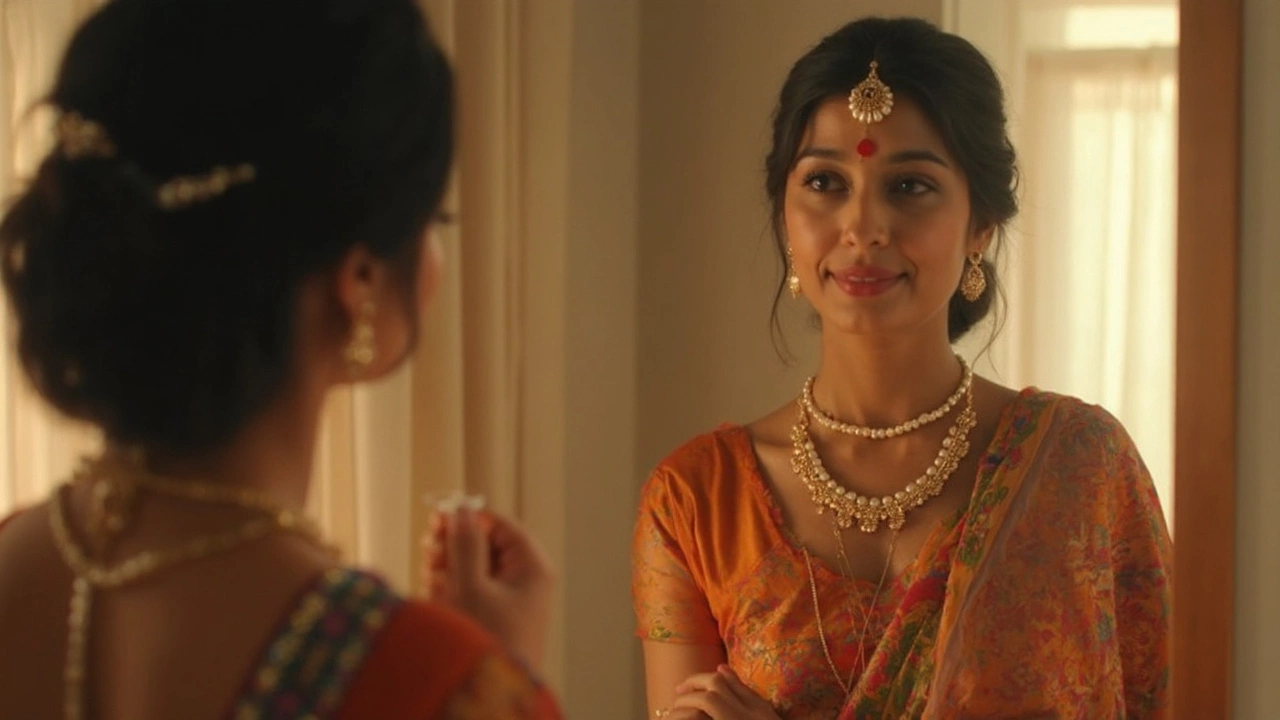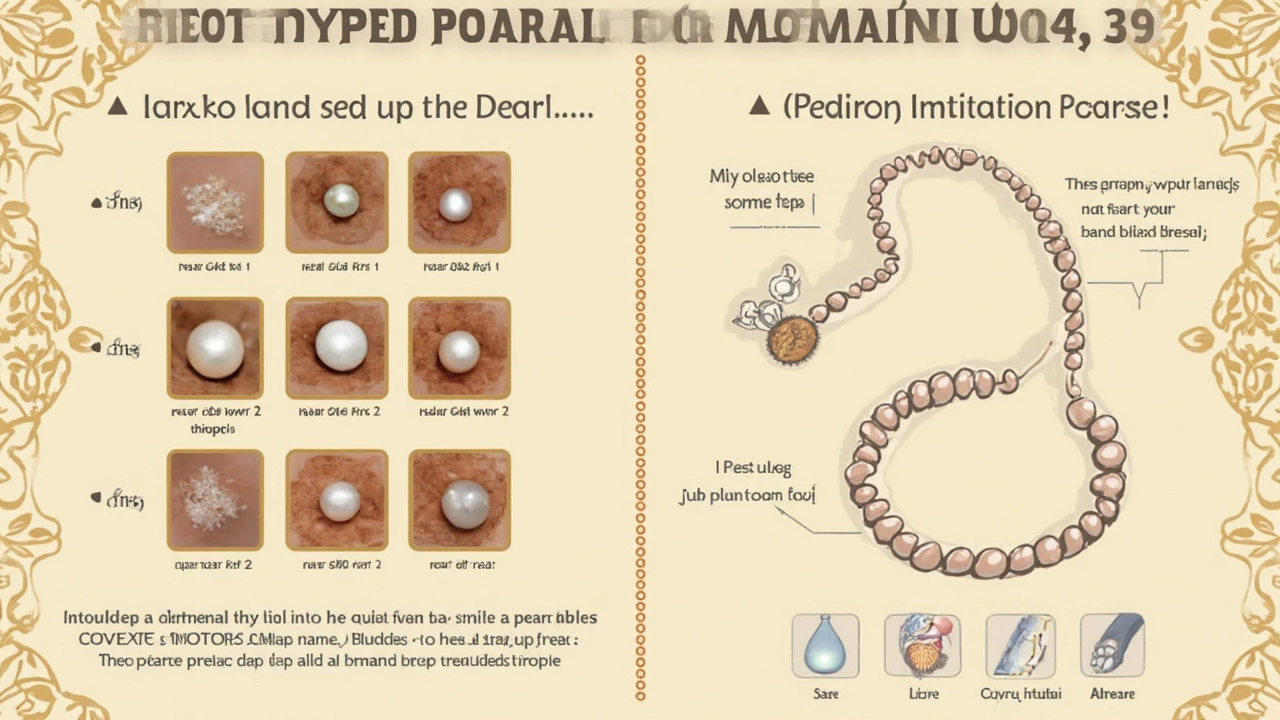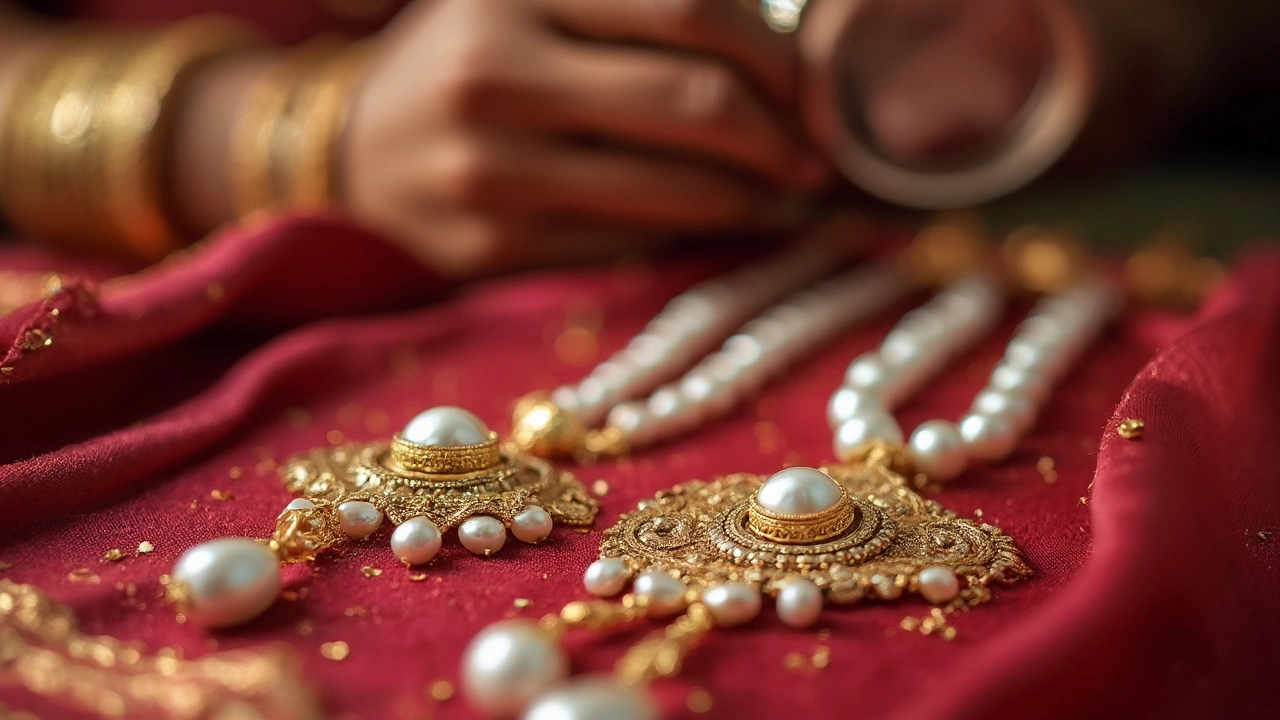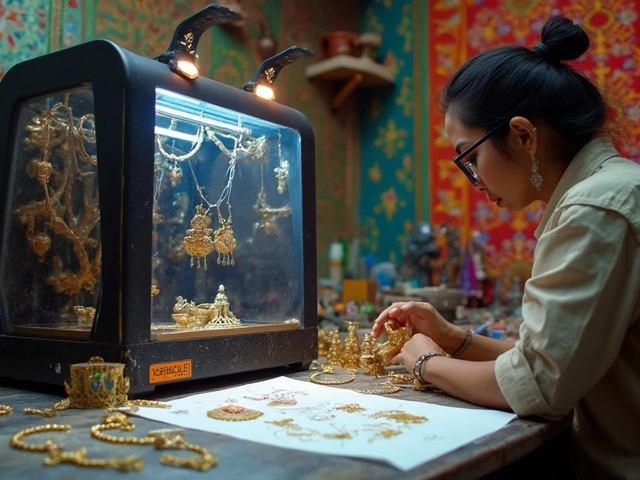Ever noticed how some mangalsutras steal the show at a wedding, while others just blend in? The secret often lies in the tiny pearls, or moti, threaded into their designs. Pearls aren’t just for looks—they have stories, traditions, and even a bit of science behind them. And if you’re thinking all pearls in mangalsutras are the same, think again. There are two main types, and knowing which is which can make a big difference to your style—and your wallet.
The two big players in the moti world are natural (real) pearls and imitation (artificial) pearls. Most traditional mangalsutra designs stick to one or the other, but sometimes you’ll see both mixed in, especially in modern pieces that blend heritage with what’s trending. Lot of folks have no idea what kind of moti they’re actually wearing—some jewelers won’t point it out unless you ask. That’s where it pays to know the basics, so you can pick something that lasts and actually fits your vibe.
- Why Pearls Matter in Mangalsutras
- Real vs. Imitation Moti: The Two Types
- How to Identify Each Moti Type
- Matching Moti Types to Your Style
- Expert Tips for Choosing and Caring for Moti
Why Pearls Matter in Mangalsutras
Pearls aren’t just there to fill up space on a mangalsutra—they’ve got meaning that goes beyond looks. For many people, wearing a mangalsutra with pearls is all about tradition, status, and a dash of science. In Indian culture, pearls stand for purity, love, and keeping things peaceful between couples. Plus, a mangalsutra with pearls is still believed by some families to bring luck and positive vibes to a new marriage.
Design-wise, adding pearls makes a mangalsutra look soft, modern, and easy to mix with any outfit. That’s why so many young brides are switching from plain gold beads to the classic moti style. Not just that, pearls actually last when you take care of them. You can pull out your mom’s or grandma’s old mangalsutra and see the pearls still looking pretty decent. It’s one of those rare jewelry choices that doesn’t go out of style.
Another thing: the type of moti (pearl) can say a lot about the piece. Moti types in mangalsutra designs pretty much decide the shine, weight, and how much you end up paying. Look at the stats below—natural pearls and imitation pearls lead the market in different price brackets:
| Pearl Type | Typical Use in Mangalsutras (%) | Average Price Range (per bead) |
|---|---|---|
| Natural (Real) Pearls | 30 | ₹150 – ₹1200 |
| Imitation (Artificial) Pearls | 70 | ₹5 – ₹50 |
That gap in price? It’s mostly because natural pearls are rare, while imitation pearls can be made in bulk. But in terms of looking good or showing off style, it comes down to what feels right for you. And let’s be real—sometimes, comfort and low maintenance win over tradition.
Real vs. Imitation Moti: The Two Types
Mangalsutras usually feature two types of moti: real pearls and imitation pearls. The difference between these two is way bigger than just price. If you know what to look for, you can easily tell them apart and make sure you’re getting what you pay for.
Real moti, or natural pearls, are formed inside oysters or mollusks. No two are perfectly alike—that’s how you spot the real deal. They’re usually a bit uneven in shape, have a subtle shine (not overly glossy), and feel slightly gritty to the touch if you rub one against your teeth. These pearls are heavier and their shine never looks plastic or ‘too perfect.’ Real moti are more durable, but they’re also pricier and need better care because things like perfume or sweat can dull their glow over time.
Imitation moti, on the other hand, are machine-made—often using glass, ceramic, or plastic, coated with a shiny finish to copy the look of natural pearls. These are totally uniform in shape and size, super smooth, and feel light. Sometimes, the coating can chip, and the shine might fade, especially if exposed to chemicals or the sun too much. The biggest plus here? They’re budget-friendly and come in all sorts of colors, so even trend-lovers can find something they like.
- Moti types in mangalsutra designs set the entire style of the piece.
- Real pearls equal more value, traditional look, and require a bit more attention.
- Imitation pearls keep costs down and let you experiment with different patterns and colors.
If you’re going for a classic, heirloom vibe and don’t mind the extra care, real moti are worth the investment. If you’re all about mixing things up or don’t want to worry about damage, imitation moti are the way to go. Understanding these options helps you get a mangalsutra that actually matches your style—plus, you’ll never get tricked at the shop.

How to Identify Each Moti Type
A lot of people look at pearls in mangalsutras and just guess what they’re made of. But if you really want to know what you’re getting (and what you’re actually paying for), here are some basic, no-nonsense ways to tell natural pearls from imitation ones.
The first thing to know: natural pearls are just what they sound like. They’re made by oysters or mussels in water—real, organic stuff. Imitation pearls, on the other hand, are usually glass, plastic, or ceramic coated to look like the real deal. Let’s check out some easy tricks for telling them apart:
- Look at the shine: Real pearls have a subtle, deep glow. It’s not just surface shine—they look a bit glowing from the inside. Imitation pearls usually catch the light only on the surface and can look too shiny or plasticky.
- Feel the weight: Real pearls often weigh more than fakes. Hold a few moti in your palm. If they feel surprisingly light, you’re probably holding imitation pearls.
- Check for imperfections: Natural pearls won’t be perfectly round or smooth. A few bumps, dents, or tiny marks are normal. Imitation pearls are usually identical—too perfect is a big giveaway.
- Do the tooth test: Gently rub a pearl against the edge of your front teeth (don’t bite, just a soft rub). Real pearls feel gritty or sandy. Fakes feel smooth or slippery.
- Look at the drill holes: Check the hole where the string runs through. Real pearls may have rough or uneven edges at the hole, while fakes usually have perfect, sharp holes.
Here’s a quick side-by-side comparison so you don’t need to remember everything. Keep this table handy when you go jewelry shopping:
| Feature | Natural Moti (Pearl) | Imitation Moti (Pearl) |
|---|---|---|
| Shine | Deep, glowing luster | Surface shine, sometimes plastic-like |
| Shape | Imperfect, not identical | Perfectly round, identical |
| Weight | Heavier | Lighter |
| Texture (Tooth Test) | Gritty | Smooth |
| Drill Hole | Rough edges | Sharp, clean edges |
If you’re buying somewhere reputable, don’t be afraid to ask them if the pearls are natural or imitation. If you’re really serious (or spending big), you can even ask for a certificate. The top shops usually give one if it’s a genuine natural pearl. One last thing—natural moti usually cost at least 2-4 times more than imitations. So if the price sounds too good, it probably is.
Matching Moti Types to Your Style
Picking the right moti type for your mangalsutra isn’t just about what’s trending—it’s about what actually fits your routine, personality, and even your budget. Natural pearls carry a kind of old-school charm and are seen as super classy, but artificial pearls win when it comes to cost and variety.
If you’re into traditions, natural pearls are what your mom or grandma probably wore in their mangalsutra. They’re known for their slight imperfections—think tiny dents or uneven shapes, which actually prove they’re real. “Nothing beats the soft glow of a real pearl in a classic mangalsutra. There’s a reason old goldsmiths still recommend them for major life events,” says Mumbai-based jewelry designer Rina Patel.
But let’s be real: natural pearls can dig a hole in your pocket, especially if you want a heavy, all-pearls design. That’s when artificial pearls come in handy. They’re often made from glass or high-quality plastic, and honestly, most people can’t tell the difference at a quick glance. Plus, you get bigger, brighter pearls without spending a fortune. Modern mangalsutras often use artificial moti for funkier, bolder designs—think geometric patterns or colored pearls that pop.
- If you want your mangalsutra for everyday wear and don’t want to stress about scratches or water, artificial moti is a safe bet.
- Want to mark a milestone or family heirloom? Go for real moti—just remember, you’ll need to handle them with care.
- Pick real or artificial based on your skin tone and what matches your outfits. Off-white natural pearls look awesome with gold and traditional sarees; bright white or colored artificial pearls are great with Indo-western looks.
Here’s a quick comparison to help you decide:
| Feature | Real Moti | Artificial Moti |
|---|---|---|
| Appearance | Off-white, unique shapes | Bright, perfectly round |
| Price | Expensive | Budget-friendly |
| Durability | Needs care | Tougher for daily use |
| Best For | Traditional, heirlooms | Trendy, daily wear |
Think about your lifestyle, not just style. If you tend to lose jewelry or change your look with the season, artificial pearls make life easier. But if you want your mangalsutra to mean something and maybe pass it down later, real pearls are the way to go. Whichever you pick, just make sure you love how it looks—and how it feels.

Expert Tips for Choosing and Caring for Moti
When it comes to picking the right moti types in your mangalsutra, it’s not just about looks. You want pearls that work with your vibe and will last the distance. Here’s what I’ve learned from both jewelers and everyday wearers.
- Check the shine and surface. Real pearls always have a soft, gentle glow—not a plastic shine. If you see perfectly smooth moti, they’re likely imitation. Real ones may have tiny natural marks.
- Feel the weight. Natural pearls feel slightly heavy for their size. Fakes are lighter and can feel oddly warm to the touch compared to the coolness of a real pearl.
- Ask about the source. Trusted jewelers will tell you exactly where their pearls come from. If they’re vague, that’s a red flag.
- Think about maintenance. Natural pearls are tougher than they look, but they don’t love perfume or strong soaps. Wipe them with a soft cloth after use, and store them in a clean pouch—don’t just toss them in with other jewelry.
- Don’t forget your lifestyle. If you wear your mangalsutra every day and you want something worry-free, imitation pearls might be a better call since you don’t have to baby them as much.
Here’s a quick look at how real and imitation pearls stack up:
| Feature | Natural Pearl | Imitation Pearl |
|---|---|---|
| Shine | Subtle, warm glow | Bright, sometimes too shiny |
| Weight | Feels slightly heavy | Lighter |
| Care needed | Wipe and store carefully | Can handle rougher use |
| Price | Higher | Budget-friendly |
| Durability | Lasts decades with care | Can chip or lose shine over time |
If you’re ever not sure, the classic tooth-test really works—gently rub the pearl against the edge of your teeth. Real pearls feel gritty; fakes feel smooth. Just remember not to do this in a fancy jewelry showroom—jewelers tend to frown on it!
The main thing is, find moti that you love, that match your needs, and that you’ll actually enjoy wearing. Mangalsutras are all about personal stories, so don’t let anyone tell you there’s only one right choice.



